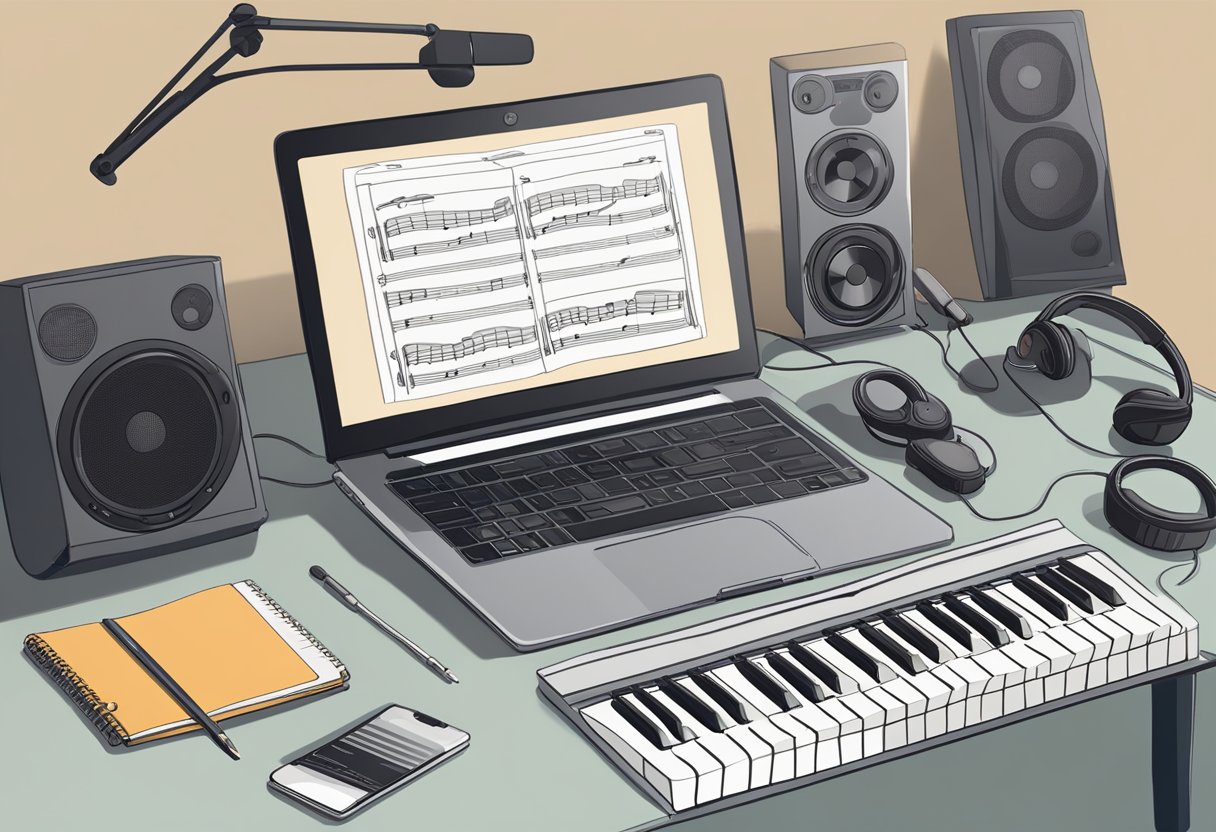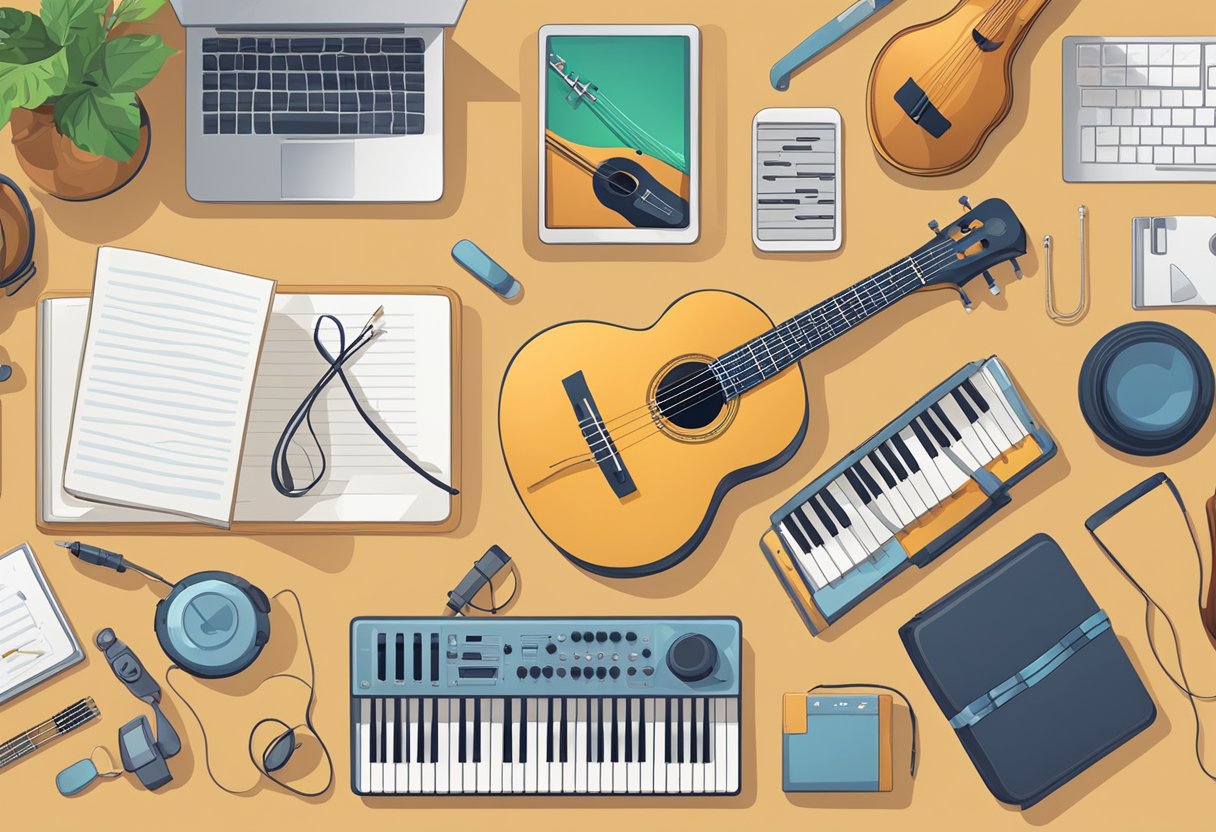

- Directory
- Recent
-
Featured
-
Featured
- Recent
-
- Programs
- Digital Nomad
- Side Gigs
- Resources
Select Page
![]() 10 people find this post amazing!
10 people find this post amazing!

With the evolution of digital technology, online music lessons have become an accessible option for students of all ages to hone their musical skills. Whether one aims to learn a new instrument, improve vocal techniques, or understand the intricacies of music theory, the virtual format offers flexibility and convenience. Equipment such as a reliable internet connection, a quality instrument, and a distraction-free environment are foundational to starting online music lessons. Additionally, it’s imperative to leverage the technology at hand, which may include using software for video conferencing, digital music sheets, and various apps designed to enhance the learning experience.
Selecting the right music teacher and structuring effective lessons are crucial to the success of online music education. It is important to find an instructor who not only has the credentials and experience but also the ability to engage with students in a virtual setting. Tailoring lesson plans to suit individual learning styles and setting achievable goals can motivate students and lead to a more fulfilling learning journey. For music teachers, understanding how to expand their teaching tools and strategies for engaging students can contribute significantly to enhancing their online music lessons, potentially leading to monetization of their skills in this medium.

When embarking on online music lessons, selecting an instrument aligns with your interests, and ensuring that you have the necessary equipment is crucial. From strings to percussion, each category requires different techniques and theoretical understanding.
String instruments like the violin and bass offer a rich avenue for music education. They demand a firm grasp of technique from the outset. A suitable violin, for example, might require an investment in a quality bow, proper strings, and regular maintenance. For bass players, aside from the instrument itself, amplification equipment may be necessary.
Wind instruments such as the flute, saxophone, and euphonium introduce learners to breath control, embouchure, and finger positioning. These instruments necessitate a student’s understanding of their physical mechanics as well as music theory to produce the desired tones. When choosing a wind instrument, consider the size and weight, especially if the student is younger or has a smaller frame.
Pianos and keyboards are often recommended for beginners due to the straightforward correlation between keys and notes, which assists in learning music theory. Equipment-wise, a digital keyboard can be a more accessible starting point due to its portability and built-in features. For percussion enthusiasts, learning techniques varies widely across different instruments within the category, but starting with a basic drum pad can be an excellent way to develop rhythm skills before investing in a full drum set.
Music theory is the cornerstone of a solid musical education, laying the foundation for understanding the language of music. It involves not just reading notes, but also understanding how those notes combine to create melodies, harmonies, and chords. Each chord has its distinct sound and function in music, forming the backbone for much of western music composition.
Key Concepts:
For those new to music theory, starting with the basics is essential. They should recognize notes on a staff and understand rhythmic values from whole notes to sixteenth notes. Recognizing major and minor scales forms a basis for developing an understanding of musical keys and the emotions they convey.
Today’s musicians also benefit from software designed to assist with music notation and theory learning. Notation software allows the user to compose and visualize music on a digital platform, offering an interactive way to understand and apply theoretical concepts.
Part of the journey in music theory is listening to and analyzing songs, dissecting the chords and rhythms to understand their purpose and effect. As the musician progresses, they may explore more complex concepts, such as chord progressions and the role of dissonance in creating tension within music.
In summary, understanding music theory is vital for any musician. It equips them with the tools to read, write, and create music effectively, thereby enhancing their overall musicality.
When beginning online music lessons, finding a music teacher who aligns with one’s goals and learning style is crucial. They should have a mix of experience, pedagogical skills, and positively reviewed by former or current students.
It is also important to consider the teacher’s commitment to students. An ideal teacher is engaged and supportive, seeking to understand the student’s needs and tailoring lessons accordingly.
Checklist for Choosing a Music Teacher:
A teacher’s ability to foster a supportive learning environment is as important as their music knowledge. Their role extends beyond mere instruction; they provide support and encouragement to inspire continued learning. Through a combination of expertise, positive reinforcement, and dedication to teaching, the right music teacher can greatly enhance the online learning experience.
The evolution of technology has made it possible to conduct effective online music lessons, bridging the gap between students and teachers regardless of their location. The successful incorporation of reliable software and proper hardware is key for an engaging and educational experience in online teaching.
Selecting the right platform is vital for delivering high-quality video lessons. Zoom has become a popular choice among music educators due to its enhanced sound quality, which is essential for conveying the nuances of music performance. Instructors may utilize specialized software such as Lessonface or EarMaster to provide interactive exercises and feedback, catering the learning experience to each student’s needs.
The quality of online classes heavily depends on both the teacher’s and the student’s hardware. A laptop or desktop with a strong internet connection ensures a stable and clear video feed, while a second camera can offer multiple viewing angles, improving lesson engagement. The use of a tablet, like an iPad, can also provide portability and ease of use. Quality headphones allow for precise audio monitoring, and a sturdy music stand is essential for holding sheet music or devices during sessions.
Teachers should ensure that all technology is tested and functioning properly before lessons begin to maximize the learning time and to minimize technical interruptions.
To elevate one’s musical abilities, focusing on practice and technique is crucial. They can begin by actively listening to each note and chord they play—attention to auditory detail can lead to great improvements in musical precision and artistry.
For vocalists, mastering breathing and posture is essential. They should engage in exercises that promote controlled breath support, which in turn, enhances the clarity and power of their voice. Singers must maintain a relaxed yet poised posture to allow for proper diaphragm movement, which is necessary for sustaining notes and achieving dynamic vocal expression.
Instrumentalists should also pay careful attention to posture, maintaining a position that fosters dexterity and minimizes strain. This consideration prevents injury and contributes to the longevity of one’s musical pursuits.
Consistent practice is key to developing consistency in performance. Musicians can track their progress through structured practice sessions that incorporate scales, etudes, and challenging pieces.
Below is a brief practice routine to incorporate:
By methodically working on each aspect of their practice and technique, musicians will see improvements in their overall performance and enjoy a more enriching musical experience.
To maximize the effectiveness of online music lessons, attention must be given to technical setup and the quality of student-teacher interactions.
Connection: The foundation of any successful online music class is a stable internet connection. Instructors and students alike should test and optimize their internet speeds to reduce the chance of interruptions. Ideal internet speed for video streaming should be at least 2 Mbps for a standard one-on-one lesson.
Latency: High latency disrupts the flow of music, making real-time playing and feedback challenging. To minimize latency, both parties can use wired internet connections instead of WiFi, close unnecessary background applications, and select servers closest to their location if using VPNs.
Sheet Music and Materials: Have digital copies of sheet music ready for sharing on-screen or through a reliable file-sharing platform. This ensures both teacher and student are literally, and figuratively, on the same page.
Feedback and Interaction: Constructive feedback is vital for student progress. Teachers can enhance interaction by using video conference tools’ features like screen annotation or digital whiteboards to highlight sections of music or write out annotations in real-time.
Online Presence and Communication: A strong online presence extends beyond the lesson itself. Regular and clear communication through emails, or a dedicated platform within the online music classes, keeps the momentum going and solidifies learned concepts.
When structuring effective online music lessons, instructors must develop a comprehensive curriculum that guides students through a logical progression of material. A well-defined lesson plan for each session should include clear objectives, materials needed, and specific activities designed to meet the learning goals.
Preparation is key to successful lesson delivery. Instructors should ensure they have the necessary technology set up and tested before lessons begin. This includes reliable internet connections, functioning audio/visual equipment, and access to digital resources. An effective lesson plan also anticipates potential technical issues and incorporates contingency plans.
To maintain a focused learning environment, teachers should establish rules and expectations at the outset. These guidelines can cover appropriate online behavior, practice expectations, and how to effectively communicate during lessons.
Encouraging student participation and engagement is vital in an online setting. Teachers must employ a range of interactive teaching methods to foster involvement, such as:
Additionally, providing immediate and constructive feedback helps students stay motivated and informed about their progress.
It is crucial for instructors to create a supportive online community that encourages collaboration among students, offering them opportunities to perform and share their work which builds confidence and a sense of accomplishment.
When entering the realm of online music lessons, engagement with both students and parents is essential. For instructors transitioning to an online format, whether it’s for an orchestra, band, or individual instruction, the manner in which they communicate with and involve parents and students can determine the success of their program.
For Students:
For Parents:
In both cases, it’s important to maintain a neutral tone and a clear and concise method of impartation, to ensure understanding and minimize misunderstandings. Keeping parents informed and involved helps build a supportive community around the student’s musical growth.
In the realm of online music education, an array of tools is available to elevate the teaching experience and extend instructors’ reach. They should consider integrating these essential components into their digital classrooms.
| Tool | Purpose | Benefit |
|---|---|---|
| Facetime | Personal lessons | Direct engagement |
| Gear | Audio/Visual quality | Professionalism |
| Social Media | Promotion/Community | Audience growth |
| YouTube Channel | Content sharing | Resource value |
| Email List | Communication | Personal updates |
Teachers should strategically employ these tools to enhance their online presence and improve the educational experience for their students.
When it comes to monetizing music skills online, instructors can harness the power of technology to reach a global audience and offer various instructional formats. They can expand their earning potential while enjoying the flexibility of teaching from any location.
One effective strategy for music teachers is to offer a range of lesson types to cater to different learning preferences and goals. Here are some tailored approaches:
Music teachers can maximize their visibility and reach potential students by leveraging online marketplaces dedicated to learning:
By diversifying their teaching offerings and using popular online platforms to connect with students, music professionals can significantly increase their income and have a more flexible and fulfilling career.
Entering the world of online music lessons marks a pivotal step in embracing the versatility that technology brings to education. As individuals pursue their passion in the music business, whether it be in performance, music production, or teaching music remotely, the right approach and tools are essential for success.
Investing in quality editing software and hardware is a strategic move. These resources enable students and instructors to convey musical nuances and comprehensive lessons effectively. A budget must be considered, but there are scalable options available to meet various financial constraints.
Hard work remains the cornerstone of progress in music. Despite the convenience of learning from one’s own space, discipline and dedication are non-negotiable. Goals should be set, practice schedules maintained, and feedback from instructors acknowledged diligently.
The transition to online will see individuals navigating a unique set of challenges. However, the ability to record sessions, access a wide array of online resources, and the potential for networking within the music community adds valuable layers to one’s musical journey.
In summary, whether a beginner or an advanced learner, the resources and strategies one employs in online music education are pivotal. They must reflect a commitment to growth, adaptability to new learning environments, and a willingness to invest in one’s musical future.
Navigating the world of online music lessons can be a rich and rewarding experience. These frequently asked questions provide clarity on the essentials for starting, structuring, and optimizing online music education.
For online music lessons, students must have a reliable internet connection, a computer or tablet with a webcam, and quality audio equipment including headphones or speakers. If the instrument they’re learning requires it, appropriate musical gear such as a piano, guitar, or other instruments is also necessary. Understanding the technical requirements is crucial for a smooth learning experience, which can be supported by guides like the one at MusicTutorOnline.
Structuring online music lessons involves setting clear objectives, having a well-planned curriculum, and allowing for flexibility in teaching methods. It’s beneficial to incorporate varied and engaging activities such as ear training, theory, and interactive music games to keep students interested. Consistency in scheduling ensures regular progress.
Identifying the right online music lessons for one’s skill level involves research and sometimes consultation with prospective instructors. Important factors to consider include the teacher’s expertise, lesson customization, and the progression pathway they offer. It’s ideal for beginners to start with programs that cover fundamentals and advanced players to seek specialized instruction.
Subscription-based services typically offer ongoing access to a range of lessons and resources for a recurring fee. In contrast, one-time payment services provide a set package or a single lesson without the commitment of a subscription. Each model offers distinct advantages; subscription services offer continual learning while one-time payments may suit those looking for targeted learning or a trial experience.
Maximizing the learning experience in virtual music lessons can be achieved by creating a dedicated learning environment, actively participating in lessons, and practicing consistently. Keeping open communication with instructors and seeking feedback also contribute to a more enriching education. Online resources can provide additional practice and theoretical knowledge to support learning.
For music instructors, the shift to online teaching opens global opportunities for reaching students. Developing digital teaching skills and creating engaging lesson plans are essential. Instructors should also focus on marketing their services and leveraging online platforms that facilitate music instruction, allowing them to build a wider student base.
Table of Contents

Achieve Your Goals Now!
